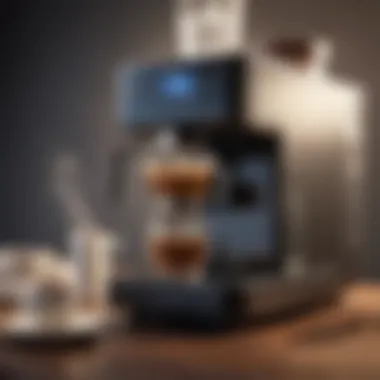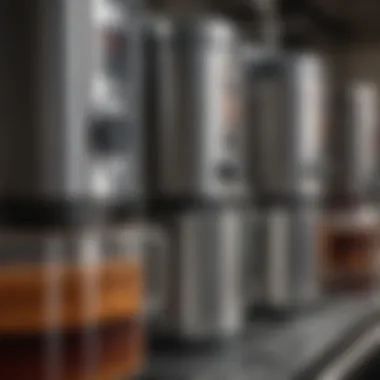Exploring the Benefits of Heated Water Reservoirs in Coffee Makers


Intro
In the realm of coffee brewing, the equipment choice profoundly influences the end result. Amongst the various options available, coffee makers featuring heated water reservoirs stand out for their unique capabilities. These machines are designed to maintain optimal water temperature throughout the brewing process, ensuring consistent and flavorful coffee. Understanding the advantages of these specialized devices can enhance your coffee-making experience significantly.
Traditionally, many coffee brewers relied on simple heating elements that may lead to inconsistencies in temperature. This inconsistency can compromise the extraction process, ultimately affecting flavor. Coffee makers with heated water reservoirs, in contrast, offer precise temperature control, allowing for an improved extraction of coffee grounds and enhancing the overall flavor profile.
This article will delve into the multifunctionality of coffee makers equipped with heated reservoirs, exploring their design, the technology behind them, and the benefits they bring to both novice and seasoned coffee enthusiasts. By examining the importance of water temperature in brewing and the decisive role these machines play, readers will gain insightful knowledge to optimize their coffee brewing methods at home. Whether you are purchasing for the first time or looking to upgrade your existing setup, this guide presents essential, actionable information.
Understanding Coffee Makers with Heated Water Reservoirs
Coffee makers with heated water reservoirs bring a significant advancement to the art of brewing coffee. These machines are designed to solve common issues faced by many coffee enthusiasts, particularly regarding temperature consistency and flavor extraction. In this section, we will explore the critical elements that make heated water reservoirs an essential feature for today’s coffee makers.
Fundamentals of Coffee Brewing
The brewing process of coffee is an intricate balance of various elements including water temperature, brewing time, and coffee grounds. Understanding the fundamentals of coffee brewing is crucial for any coffee lover. There are specific temperatures where coffee flavors are best extracted. When the water is too cold, the resulting brew can lack the rich and robust flavors desired. Conversely, if the water is too hot, it can lead to over-extraction, creating a bitter taste. A heated water reservoir ensures that the water reaches the optimal brewing temperature, typically between 195°F to 205°F, which is critical for achieving the best flavor profile. This knowledge elevates the experience for both casual drinkers and connoisseurs alike.
Functionality of Heated Water Reservoirs
Heated water reservoirs provide several practical benefits that enhance the brewing experience. First, they maintain a constant temperature throughout the brewing cycle. This consistency is paramount in delivering a balanced flavor in each cup.
Secondly, these reservoirs often heat the water ahead of time, reducing the wait for a fresh pot of coffee. Unlike traditional coffee makers that take time to heat water each time, machines with heated reservoirs are generally ready to brew when needed. This capability makes them time-efficient, particularly for those who prefer multiple cups throughout the day or for gatherings.
In addition, heated water reservoirs often come equipped with temperature control settings that allow users to choose their preferred brew temperature. This feature can cater to different coffee types, ensuring that each variety is brewed under the ideal conditions necessary for optimal flavor extraction.
"By understanding how heated water reservoirs function, you can leverage their benefits to enhance your daily coffee experience."
Benefits of Using a Heated Water Reservoir
The integration of heated water reservoirs in coffee makers leads to several advantages that enhance the brewing experience. Understanding these benefits is crucial for consumers seeking quality coffee with consistent flavor profiles. This section explains the major benefits of using a coffee maker with a heated water reservoir, focusing on consistency in brew temperature, enhanced flavor extraction, and improved time efficiency. Each of these elements contributes significantly to the overall quality of the coffee brewed and the satisfaction of the drinker.
Consistency in Brew Temperature
Achieving the right temperature during the brewing process is vital for optimal coffee extraction. The heated water reservoir maintains a stable temperature, ensuring uniform heating from the start to the end of the brew cycle. This consistency means that each cup is brewed under identical conditions, preventing variations that occur in traditional coffee makers.
- Quality Control: Maintaining a consistent brew temperature regulates extraction, resulting in a well-balanced flavor. Coffee enthusiasts appreciate this reliability.
- Brewing Range: Coffee makers with heated reservoirs often offer precise temperature controls, allowing users to select their preferred temperature settings.
- Avoiding Over-Extraction: High fluctuations in temperature can lead to over-extraction, causing bitterness. A stable temperature minimizes this risk.
In summary, the ability to consistently maintain proper brewing temperatures significantly enhances the taste and quality of brewed coffee.
Enhanced Flavor Extraction
Flavor extraction is a crucial aspect of coffee brewing, directly influenced by water temperature and consistency. Heated water reservoirs optimize this extraction process, promoting enriched flavor profiles.
- Ideal Temperature: Higher temperatures release oils and soluble compounds from coffee grounds, leading to fuller flavors. The heated reservoir ensures the brewing temperature remains within the ideal range, typically between 195°F to 205°F.
- Less Compromise: Unlike some traditional methods, where temperature can drop as water passes through the grounds, a heated reservoir continually maintains the water at the right temperature until brewing is complete.
- Enhanced Aroma: The combination of optimized temperatures and consistent brew times leads to coffees that are aromatic and flavorful, satisfying even discerning palates.
The result is a coffee experience that brings out subtle notes and complexity, which might be overlooked in lower-quality brews.
Time Efficiency
Another significant advantage of heated water reservoirs is the reduction in brew time without sacrificing quality. This efficiency is particularly valuable for individuals with busy lifestyles who still prioritize excellent coffee.
- Immediate Heating: Many coffee makers with heated reservoirs reduce the wait time for brewing since the water is preheated. This means less time from start to enjoying a cup.
- On-Demand Coffee: For users who desire multiple cups throughout the day, a heated reservoir can supply hot water quickly, making it easy to brew more coffee on demand.
- Less Waiting: Time spent waiting for the coffee maker to heat the water is minimized. This not only improves user experience but also encourages more frequent coffee consumption.
In essence, a coffee maker with a heated water reservoir supports a swift and convenient brewing process, allowing enthusiasts to enjoy their beverages promptly.


Technical Aspects of Heated Water Reservoirs
Understanding the technical aspects of heated water reservoirs is essential for appreciating their role in coffee brewing. These devices combine ingenuity with engineering, designed to ensure that your coffee is not just made quickly but brewed to perfection. The key components—heating elements, temperature control methods, and construction materials—contribute significantly to the functionality and performance of these coffee makers.
Heating Elements Explained
Types of Heating Elements
There are mainly two types of heating elements found in coffee makers with heated water reservoirs: resistive heating elements and thermoblock heaters.
- Resistive heating elements utilize a wire that heats up when electricity flows through it. This type is common in traditional coffee makers.
- Thermoblock heaters, on the other hand, heat water on demand as it passes through a metal block, making it an efficient component for maintaining consistent temperatures.
The primary characteristic that makes resistive heating elements a popular choice is their reliability, offering uniform heating through the water reservoir. However, they can take longer to achieve optimal temperature. In contrast, thermoblock heaters provide faster response times but may have limitations in maintaining high volume for larger servings.
Ultimately, the choice of heating element affects not only the efficiency of brewing but also the flavor extraction from the coffee grounds.
Safety Features
Safety is a crucial aspect of any electrical appliance, and coffee makers with heated water reservoirs are no exception. Key safety features include overheating protection, automatic shut-off, and non-slip bases to prevent accidental spills.
The inclusion of overheating protection ensures that the appliance does not reach dangerous temperatures during use, thus preventing potential hazards. Automatic shut-off is also a beneficial characteristic, allowing the machine to turn off after a specified period of inactivity. This feature not only conserves energy but also enhances safety.
While these safety features contribute largely to user confidence, they can sometimes lead to inconvenience if not functioning correctly. An automatic shut-off that activates prematurely might interrupt brewing cycles or lead to inconsistency in your cup of coffee.
Water Temperature Control Methods
Maintaining the right water temperature is essential to brewing coffee properly. Various methods are employed to manage this aspect. Some coffee makers utilize thermistors to monitor temperature, while others may incorporate PID controllers for more precise management. These technologies ensure that the water remains within optimal brewing ranges, enhancing the extraction of flavors from the coffee grounds.
Materials Used in Construction
Durability Considerations
Durability in coffee makers is paramount since a high-quality product must withstand daily use. Stainless steel and high-grade plastics are favored materials, both for their resilience and their ability to withstand high temperatures.
These materials are not only strong but also less prone to rust or corrosion. Stainless steel has the added advantage of being easier to clean and maintain. However, it can make the machine heavier, which might not be desirable for everyone. Ultimately, the choice of materials can affect the longevity of the coffee maker.
Maintenance Needs
Consideration of maintenance needs should not be overlooked. Coffee makers with heated water reservoirs typically require regular cleaning to prevent mineral buildup and ensure optimal functioning.
Many modern designs incorporate self-cleaning features, which greatly ease the task of maintenance for the user. Nonetheless, self-cleaning mechanisms can sometimes necessitate the use of specific cleaning solutions, which might add to overall costs over time.
Comparative Analysis of Brewing Methods
In the realm of coffee preparation, the choice of brewing method significantly influences the flavor and aroma of the final cup. This section aims to clarify the distinctions among various coffee makers, particularly those with heated water reservoirs. By understanding different brewing techniques, consumers can make informed decisions that align with their taste preferences and lifestyles.
Traditional Drip Coffee Makers
Traditional drip coffee makers are a staple in many households. They operate by heating water and dripping it through coffee grounds contained in a filter. One advantage of these machines is their simplicity. Users only need to add water and grounds, often setting a timer for automatic brewing.
However, temperature consistency can be a challenge. Many models do not maintain optimal heat levels throughout the brewing process. Coffees brewed from these machines can sometimes lack depth in flavor due to uneven extraction. This can be mitigated by using high-quality coffee grounds and pre-heating the water.
Single-Serve Machines
Single-serve machines, such as Keurig or Nespresso, provide convenience for users who prefer fresh coffee without hassle. These machines use pods for quick brewing, ensuring that each cup has its own fresh flavor.


The downside is often the higher cost per cup compared to traditional methods. Additionally, while the brewing temperature is usually standard, it may not always cater to individual taste preferences. Temperature controls are less flexible in these machines. Thus, while they offer efficiency, they can sacrifice some aspects of brewing quality that aficionados might desire.
Espresso Machines
Espresso machines are designed for brewing strong, concentrated coffee. These machines use pressurized water to extract flavors from finely-ground coffee. The result is a rich and bold cup that serves as a base for popular coffee drinks like lattes and cappuccinos.
Heated water reservoirs provide better temperature stability, crucial for creating the perfect espresso shot. These machines tend to be more complex than drip coffee makers or single-serve options, requiring more attention and skill. However, the rewards are significant. Many enthusiasts argue that nothing compares to the depth of flavor and aroma produced by a well-executed espresso shot.
"The choice of brewing method is essential in achieving the desired taste profile, impacting the overall coffee experience."
The End
The comparative analysis of these brewing methods highlights the unique traits each coffee maker possesses. The choice ultimately depends on personal preferences. Understanding differences in technology and functionality lays the groundwork for making an informed selection in ensuring impeccable coffee quality.
Impact of Temperature on Coffee Quality
Understanding the impact of temperature on coffee quality is crucial for any coffee aficionado or casual drinker alike. Brewing coffee at the right temperature can significantly affect the flavor and overall experience. Coffee makers that utilize heated water reservoirs provide a method to consistently maintain these optimal temperatures. The nuances of how heat interacts with coffee grounds cannot be overstated. Specifically, temperature influences the extraction of coffee solubles, which are essential for achieving the desired taste profile.
Optimal Brewing Temperatures
The optimal temperature range for brewing coffee typically lies between 195°F and 205°F (90°C to 96°C). At these temperatures, water effectively extracts oils, acids, and other compounds from coffee grounds. If the water is too cold, the extraction process slows down, resulting in a weak and underwhelming cup. Conversely, if the water reaches temperatures exceeding 212°F (100°C), it can scorch the coffee, leading to a bitter taste and unpleasant aroma.
Proper heated water reservoirs help maintain these recommended temperatures throughout the brewing cycle. They achieve this through precise temperature control mechanisms. The presence of a heated water reservoir minimizes the temperature fluctuations common in standard drip coffee makers. Such variability can have a profound effect on the quality of the brew, often leading to an inconsistent output. With a reliable reservoir, users can expect a consistently rich cup every time they brew.
Influence of Water Temperature on Flavor
Water temperature directly affects the flavor profile of the coffee. Each coffee bean type has its unique composition of oils and acids, which require different extraction temperatures for optimal flavor. For instance, lighter roasts tend to favor slightly higher temperatures compared to darker roasts. A well-designed coffee maker with a heated water reservoir allows for this variation easily.
When brewing coffee, the right temperature ensures a balanced extraction of flavors. Too hot water can lead to excessive extraction of bitter compounds, while too cold can leave the sweeter notes undeveloped. This fine line is critical for those who appreciate a complex cup.
"Proper water temperature is essential not just for extraction, but for ensuring the coffee’s aromatic profile is fully realized."
Choosing the Right Coffee Maker with Heated Water Reservoir
Selecting an appropriate coffee maker with a heated water reservoir is crucial for ensuring the highest quality of coffee. The right choice directly influences both flavor and convenience in the brewing process. The market offers a variety of models, each with unique features and specifications. Thus, understanding these essential attributes becomes fundamental when making a decision.
Key Features to Consider
Capacity
Capacity refers to the amount of coffee the machine can brew in a single cycle. This aspect plays a significant role, especially for households with multiple consumers or those who frequently host gatherings. A larger capacity allows for brewing several cups at once, eliminating the need for multiple brewing sessions. This saves both time and effort.
Moreover, such models reduce wastage of coffee that may result from brewing excess amounts. When considering capacity, potential users should assess not just their immediate needs, but also potential changes in their coffee habits over time. For example, families may expand or friends may gather more often. A flexible capacity provides adaptability.
Programmability
Programmability represents another pivotal feature. This characteristic allows users to pre-set brewing times. Imagine waking up to the aroma of freshly brewed coffee without the need to lift a finger. This feature is particularly beneficial for busy individuals. Users can plan their coffee for any time – it could be post morning exercise or mid-afternoon into evening sessions.
A coffee maker with programmability also often includes customization options for brew strength and volume. This means less trial and error in crafting a perfect cup. Though more complexity in programming may intimidate some, the long-term benefits far outweigh initial apprehensions. Thus, a programmable machine aligns with the goal of creating a routine around coffee enjoyment.
Budget Considerations
Budget is an important aspect when choosing any appliance, including coffee makers. The price range for machines with heated water reservoirs can vary significantly based on the features offered. Basic models can be less expensive, but may not include advanced aspects such as programmability or larger capacity.


Investing in a quality machine will often translate into better durability and consistent performance over time. To find the right balance between features and cost, it’s wise for consumers to establish a clear budget, while also considering their personal coffee habits.
Maintaining a Coffee Maker with Heated Water Reservoir
Caring for a coffee maker with a heated water reservoir is vital for maintaining its performance and ensuring high-quality brews. Regular maintenance not only enhances the lifespan of the machine but also preserves the integrity of the flavor extracted from the coffee grounds. A well-maintained coffee maker produces better tasting coffee, which is particularly important for enthusiasts who appreciate the subtleties of flavor and aroma.
Regular Cleaning Practices
Cleaning coffee makers with heated water reservoirs is essential to maintain their taste and efficiency. Regular cleaning can prevent the buildup of oils and residues that alter the taste of the coffee. Ideally, you should clean the coffee maker after every use. This entails flushing the reservoir with clean water and wiping down any surfaces that may have been in contact with coffee grounds or brewed coffee.
To perform an effective clean:
- Rinse the water reservoir: After each brew, rinse the reservoir thoroughly to remove any leftover water and coffee oils.
- Clean the brew basket: Remove the brew basket and clean it with warm soapy water, ensuring all residue is scrubbed away.
- Wipe exterior surfaces: Use a damp cloth to clean the machine’s outer surfaces.
Additionally, manufacturers often provide specific cleaning instructions in the product manual, which should be followed closely for optimal results.
"Regular maintenance of your coffee maker can stop the buildup of mineral deposits, leading to tastier coffee and a longer-lasting machine."
Descaling Techniques
Descaling is another crucial aspect of maintaining a coffee maker with a heated water reservoir. Over time, mineral buildup from water can affect the machine's performance and efficiency. This buildup can lead to issues such as slow brewing times and uneven temperatures, which ultimately impacts the coffee quality.
To descale effectively:
- Use a descaling solution: Many brands offer their own descaling products, which are formulated for optimal effectiveness. White vinegar can also be a cost-effective alternative.
- Dilute the solution: If using vinegar, typically a mixture of one part vinegar to one part water is recommended.
- Run a descaling cycle: Pour the solution into the reservoir and run a brewing cycle without coffee grounds. Allow the machine to brew as if you were making coffee.
- Rinse thoroughly: After descaling, run multiple brewing cycles with clean water to ensure all residues are removed. This step is essential to avoid an off-taste in future brews.
By incorporating both regular cleaning and descaling into your maintenance routine, you will ensure your coffee maker operates optimally, resulting in consistently delicious coffee.
User Reviews and Experiences
User reviews and experiences play a crucial role when evaluating coffee makers with heated water reservoirs. They provide real-world insights on performance, usability, and overall satisfaction. Today’s coffee consumer often seeks out reviews for guidance before making a purchase, given the vast array of options available in the market.
Understanding users’ perspectives can reveal strengths and weaknesses that may not be apparent from product specifications alone. Reviews often highlight specific features that work well, such as consistent temperature retention or ease of use. Additionally, they can inform potential buyers about aspects like design and maintenance that impact long-term satisfaction.
Common Praise
Many users appreciate the efficiency that coffee makers with heated water reservoirs provide. A common point of praise is the consistency in brew temperature, which is crucial for achieving optimal flavor extraction.
Users often report:
- Faster brewing times: Heated reservoirs hold water at the ideal temperature, thus reducing the wait time for freshly brewed coffee.
- Improved flavor profiles: Customers frequently note that their coffee tastes richer and more balanced, attributing this to the precise temperature control these machines facilitate.
- Convenience: For those who brew multiple cups or vary their coffee styles, having water readily heated simplifies the process. Users can easily transition from making a standard brew to an espresso without delay.
"My coffee tastes completely different since I switched to a maker with a heated reservoir. You really notice the difference in taste!" - Satisfied User
Addressing Negatives
I've found several recurring points in the reviews:
- Higher price point: These machines tend to be pricier compared to traditional models. Some users mention that this can be a barrier to entry for those who want the added benefits without extensive investment.
- Potential for overheating: A few users have reported issues with water becoming too hot, potentially leading to burnt flavor.
- Energy use: Continuous heating can lead to higher electricity bills. Many coffee enthusiasts weigh the benefits against their energy costs, leading to discussions about sustainability.
Epilogue
The conclusion plays a crucial role in synthesizing the rich information presented throughout this article. It provides readers with a coherent summary while reinforcing the significance of coffee makers with heated water reservoirs. These devices are not just about convenience; they fundamentally enhance the coffee brewing experience.
Summary of Key Points
- Technology: Heated water reservoirs maintain a consistent brewing temperature, which is essential for effective coffee extraction. This leads to better flavor profiles and aromatic qualities in the final cup.
- Efficiency: The time saved by having water heated on demand cannot be understated. Consumers enjoy quickly brewed coffee without compromising on quality.
- Versatility: Users can experiment with different coffee types and brewing styles, thanks to the precise temperature control offered by advanced coffee makers.
Final Thoughts on Heated Water Reservoirs
In summary, coffee makers with heated water reservoirs stand out for their temperature stability, efficiency, and ultimate coffee quality. When choosing the right machine, consider your brewing habits and preferences. Such machines aren't merely a luxury; they can enhance the daily ritual of coffee making into a more enjoyable and rewarding experience. Whether one is an aficionado or a casual drinker, understanding these advantages can lead to more informed purchasing decisions. Investing in a well-designed coffee maker can transform your mornings, enabling you to appreciate every sip.















